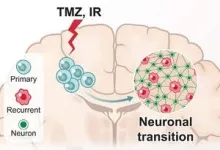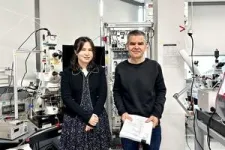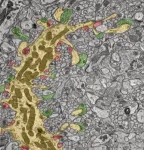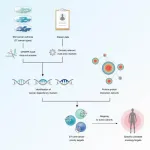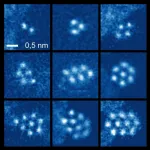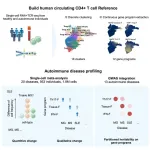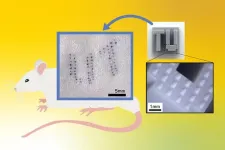(Press-News.org) MIAMI, FLORIDA (EMBARGOED UNTIL JAN. 11, 2024, at 11 AM EST) – Certain cancers are more difficult to treat because they contain cells that are highly skilled at evading drugs or our immune systems by disguising themselves as healthy cells.
Glioblastoma, for example, an incurable brain cancer, is characterized by cells that can mimic human neurons, even growing axons and making active connections with healthy brain neurons. This cancer is usually deadly – average survival time is just over one year from diagnosis – because it almost always recurs after initial treatment and recurrent tumors are always resistant to therapy.
But now, a new study by researchers at Sylvester Comprehensive Cancer Center at the University of Miami Miller School of Medicine and collaborating organizations provides insight into this neuron mimicry and potential therapies to prevent treatment resistance. Their work appears Jan. 11 in the journal Cancer Cell.
“Our findings were made possible by a unique approach to studying glioblastoma,” explained Antonio Iavarone, M.D., deputy director at Sylvester who led the study with Jong Bae Park, Ph.D., of the National Cancer Center in Korea. Iavarone noted that they used a platform designed to study glioblastoma cells’ full set of proteins, also known as the proteome, and certain modifications on those proteins indicating enzyme activity in cells.
“These platforms can provide a landscape of alterations in individual tumors that you cannot get from genetics alone,” he added.
Largest dataset to date
The research team assembled what became the largest dataset of its kind, featuring matched tumor samples from 123 glioblastoma patients both at diagnosis and then recurrence after initial therapy. By studying the tumors’ proteomes and protein modifications in the samples, researchers were able to detect important changes not previously seen in similar cancer studies that examined the tumors’ genomes or transcriptomes, the set of RNA molecules in cancer cells.
This study represents the first time scientists have used proteomics to study glioblastoma’s transition from treatable to treatment-resistant, according to the researchers. By looking at cancer proteins and their modifications, namely a specific modification known as phosphorylation, they demonstrated that before treatment, glioblastoma cells were in a proliferative state where the cells expend energy toward replicating themselves.
Many chemotherapies work by targeting the cell functions in self-replication, as cancer cells typically grow faster than healthy cells. But once tumors recurred in glioblastoma patients months later, the cells looked very different – and more like healthy neurons.
The researchers asserted that there is something about this replication-to-neuronal transition that helps cancer cells evade being killed by the initial glioblastoma treatment, usually a combination of chemotherapy, radiation and surgery.
“The tumor cells actually resemble normal brain cells,” said Simona Migliozzi, Ph.D., an assistant scientist at Sylvester and one of the study’s lead authors. “Why? Because tumor cells want to survive, they want to live, and they’re able to acquire therapy resistance by mimicking the normal brain.”
Finding glioblastoma weaknesses
The authors then used their new dataset to identify potential therapies that could kill these resistant cancers, focusing on enzymes known as kinases that are responsible for phosphorylating other proteins. Migliozzi and colleagues deployed a machine-learning approach they had developed previously to find the most active kinases in the neuron-like glioblastomas. Kinases are important for many different cellular functions and are key targets for many FDA-approved cancer drugs.
One kinase stood out: BRAF. Gene encoding for this kinase is commonly mutated in some cancers, including melanoma, but in glioblastoma, BRAF protein levels increase without corresponding gene changes. The researchers would not have made this important discovery without examining the cancer proteome.
They then tested an existing BRAF inhibitor, vemurafenib, on treatment-resistant glioblastoma cells in a petri dish and a patient-derived xenograft tumor in mice. In both cases, the drug, used in combination with the chemotherapy drug temozolomide, knocked down the formerly resistant tumors. In the mouse model, the BRAF inhibitor extended the animals’ survival over chemotherapy alone.
Future plans
Iavarone believes their artificial-intelligence algorithm to predict glioblastoma’s most active kinase can be applied to other cancer types. He and his researchers are working to develop a clinical test that would use AI to identify therapeutic weaknesses in a variety of cancers by finding each tumor’s most active kinase and treating it with an existing kinase inhibitor.
Presently, Iavarone and colleagues are discussing plans for a clinical trial testing vemurafenib or another BRAF inhibitor drug for glioblastoma. They plan to treat trial patients with the inhibitor from the start to prevent the cancers from transitioning to the resistant state.
“Proteomics give us a much more direct prediction of protein activity,” Iavarone said. “We hope this analysis can be seamlessly translated into the clinic as a next-generation precision therapy for this very challenging disease and other resistant cancers as well.”
about this important discovery on the InventUM blog [insert link when available] and follow @SylvesterCancer on X for the latest in cancer research and care.
# # #
Photo Caption/Credit: “Proteomics give us a much more direct prediction of protein activity,” said Antonio Iavarone, MD, deputy director at Sylvester and the study’s lead author. “We hope this analysis can be seamlessly translated into the clinic as a next-generation precision therapy for this very challenging disease and other resistant cancers as well.” Photo by Sylvester
Article Title: Integrated Proteogenomic Characterization of Longitudinal Glioblastoma
Authors: The complete list of authors is noted in the research article.
Funding: NIH grant R35CA253183 to Iavarone
END
A new study led by researchers from the UCLA Health Jonsson Comprehensive Cancer Center shows that using high doses of radiation while integrating an ablative radiotherapy technique called stereotactic ablative radiotherapy (SABR) concurrently with chemotherapy is safe and effective in treating people with locally advanced non-small cell lung cancer that is not suitable for surgery.
Based on mid-treatment response, researchers found the combination treatment, which involves a second radiation plan to personalize a boost for the last third of radiation treatments, is a viable and promising option that helps reduce the risk of toxic side effects and having the cancer ...
Whether picking up a small object like a pen or coordinating different body parts, the cerebellum in the brain performs essential functions for controlling our movement. Researchers at the Institute of Science and Technology Austria (ISTA) investigated how a crucial set of synapses between neurons within it functions and develops. Their findings have now been published in the journal Neuron.
Even if you do not think about it, every day you are using the intricate circuits of neurons in your brain to perform astonishingly delicate movements with your body. One essential unit in this is the cerebellum playing a key role in fine motor control, coordination, and timing.
“Every ...
UPTON, NY—Scientists at the U.S. Department of Energy’s (DOE) Brookhaven National Laboratory and Columbia University have developed a way to convert carbon dioxide (CO2), a potent greenhouse gas, into carbon nanofibers, materials with a wide range of unique properties and many potential long-term uses. Their strategy uses tandem electrochemical and thermochemical reactions run at relatively low temperatures and ambient pressure. As the scientists describe in the journal Nature Catalysis, this approach could successfully lock carbon away in a useful solid form to offset or even achieve negative carbon emissions.
“You can put the carbon nanofibers ...
About The Study: The findings of this study of 6,101 adult cancer survivors suggest that substance use disorder (SUD) prevalence is higher among survivors of certain types of cancer; this information could be used to identify cancer survivors who may benefit from integrated cancer and SUD care. Future efforts to understand and address the needs of adult cancer survivors with comorbid SUD should prioritize cancer populations in which SUD prevalence is high.
Authors: Devon K. Check, Ph.D., of the Duke University School of Medicine in Durham, North Carolina, is the corresponding author.
To access the ...
About The Study: In this study of patients diagnosed with head and neck cancer from 2017 to 2020 in the U.S., the incidence of localized head and neck cancer declined during the first year of the pandemic. A subsequent increase in advanced-stage diagnoses may be observed in later years.
Authors: Nosayaba (Nosa) Osazuwa-Peters, B.D.S., Ph.D., M.P.H., C.H.E.S., of the Duke University School of Medicine in Durham, North Carolina, is the corresponding author.
To access the embargoed study: Visit ...
A new, systematic analysis of cancer cells identifies 370 candidate priority drug targets across 27 cancer types, including breast, lung and ovarian cancers.
By looking at multiple layers of functional and genomic information, researchers were able to create an unbiased, panoramic view of what enables cancer cells to grow and survive. They identify new opportunities for cancer therapies in a significant leap towards a new generation of smarter, more effective cancer treatments.
In the most comprehensive study of its kind, researchers ...
AI language models are booming. The current frontrunner is ChatGPT, which can do everything from taking a bar exam, to creating an HR policy, to writing a movie script.
But it and other models still can’t reason like a human. In this Q&A, Dr. Vered Shwartz (she/her), assistant professor in the UBC department of computer science, and masters student Mehar Bhatia (she/her) explain why reasoning could be the next step in AI—and why it’s important to train these models using diverse ...
For the first time, scientists have succeeded in the stabilisation and direct imaging of small clusters of noble gas atoms at room temperature. This achievement opens up exciting possibilities for fundamental research in condensed matter physics and applications in quantum information technology. The key to this breakthrough, achieved by scientists at the University of Vienna in collaboration with colleagues at the University of Helsinki, was the confinement of noble gas atoms between two layers of graphene. This method overcomes the difficulty that noble gases do not form stable structures under experimental conditions ...
Osaka, Japan – Much like ripples on the water can betray powerful currents below the surface, small changes in our bodies can sometimes be an indicator of a serious condition. Now, researchers from Japan say that cells in the blood may provide telltale signs of important immune dysfunction.
In a study recently published in Cell Genomics, researchers from Osaka University have revealed that subtle changes in specific immune cell populations may signal the presence of an autoimmune disease.
In autoimmune conditions, which affect up to 5% of the population, the body’s immune cells attack the body ...
Tokyo, Japan – If you’ve ever taken a car trip through a rural area, you might already know that livestock, including cows and sheep, can be individually tracked using decidedly old-fashioned methods, such as ear tags or even branding marks. By contrast, many tech-savvy pet owners have opted to have their dog or cat “chipped” by having a radio frequency identification (RFID) permanently implanted under the skin. However, all these identification solutions leave something to be desired, as ear tags can become damaged or lost, while RFID chips require an invasive procedure to insert and specialized equipment to read.
In a study recently published in Scientific ...

